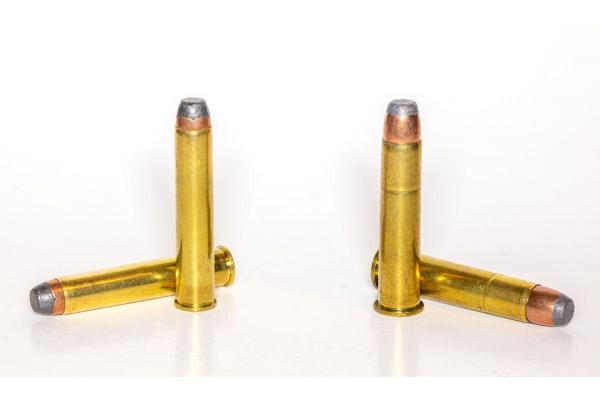The 444 Marlin and 4570 Government calibers have been engaged in a back-and-forth battle for decades
Though arguing whether the .444 Marlin is better than the 45-70 government might make time around a campfire more fun, it’s mostly a waste of time.
The free market (meaning, most shooters), has already answered this question, and the 45-70 government is the winner.
As proof, the first rifle introduced by Marlin after they were acquired by Ruger in 2000 was not a 444 Marlin, it was a 4570 government rifle.
Another good indication of popularity is factory ammunition; there are seven times as many factory 45-70 government loads as there are for the 444 Marlin cartridge.
Both are fantastic cartridges that fill a similar niche, so why and how did the 4570 government, which was nearly extinct when the 444 Marlin was introduced, rise from the ashes and push the newer cartridge into near obsolescence? To understand that a little history is in order.
History of the 4570 Government Cartridge
Let’s start in 1873, which was the year the 45-70 government cartridge was introduced.
Developed for the U.S. Army’s Trapdoor Springfield, the 45-70 rifle caliber was originally loaded with a 405-grain, 0.458-caliber bullet, ahead of 70-grains of black powder.
This is of course how the 45-70 cartridge got its name.
The load produced a muzzle velocity of about 1,300 fps or so, with somewhere around 1,500 foot-pounds of muzzle energy. By modern standards, that’s not impressive, but in 1873 it got folks' attention.


Up until the middle of the first decade of the next century, the 4570 government cartridge was popular.
But that’s when rifle cartridges with smokeless powder, like the .30-06, far outpaced their performance.
By the end of World War I, the 45-70 had lost its appeal and Marlin had stopped making the original Model 1895 it was chambered in.
In an effort to stay competitive and meet demands, Marline created a new cartridge in 1964 very similar to the 45-70. It was essentially an elongated .44 Magnum cartridge that fired a 0.430-inch diameter bullet. For some reason, maybe due to its .44 Magnum heritage, it was named the 444 Marlin, and Marlin chambered this cartridge in their Model 336 lever action rifle.
The 444 became popular and because it was loaded to a maximum pressure of 42,000 psi, it was much more powerful than the 4570 government cartridge of the last century.
But alas, the popularity and performance of the 444 Marlin were the inspiration that revived the 45-70 government ammunition. In 1972 Marlin chambered their Model 336 lever gun for 45-70 and renamed it the Model 1895.
Improved 4570 Ballistics Performance
What happened next helped the 45-70 government become one of the most popular lever action rifle cartridges of all time.
Ammunition manufacturers stepped up, and by using modern smokeless powders they began creating 45-70 ammunition that would rival the performance of the 444 Marlin.
They did this while still respecting the extremely low 28,000-psi pressure restriction which was established because of the old trapdoor rifles.
But most importantly, some ammunition manufacturers realized that if Marlin’s lever gun could handle the 42,000 psi of 444 Marlin ammunition, it could also handle higher pressure 45-70 ammunition loads, and +P, “heavy,” and “magnum” 45-70 government loads were born.
As a result, shortly after Remington acquired Marlin in 2008 the 444 Marlin rifle was discontinued.
The 4570 government caliber had evolved from an antiquated black powder cartridge to a modern, smokeless powder cartridge that offered an un-heard of, three power levels of performance.
Because there are still trapdoor 45-70 munitions out there, and because cowboy action shooting became so popular, factory 4570 ammunition loads replicating its original ballistics have been and still are available.
They’re great for playing cowboy and for big-game at close range.
Digging a couple of levels deeper, we can see that 45-70 ammunition loads began to move the needle.
A standard modern load featuring a 300-grain bullet at about 1,850 fps delivers 50 percent more kinetic energy than the 4570 government’s original loading.
It also competes well with the standard 444 Marlin load of a 240-grain bullet at around 2,250 fps. The 444 Marlin still hit a bit harder and shot a bit flatter, but it also had slightly more recoil.
It was those +P, “heavy,” and “magnum,” 45-70 ammunition loads that made the real difference.
With the 4570 government caliber, not only could you shoot light recoiling cowboy loads, and loads similar in performance to the 444 Marlin, but you also had the option of bad-ass, bone-crushing, loads capable of handling any critter walking earth.
A 300-grain Barnes TSX bullet at 2,300 fps delivers 3,500 foot-pounds of energy and a 225-grain Xtreme Defense bullet at 2,700 fps shoots pretty darn flat. The 444 Marlin could not compete with this versatility or the 45-70 government’s top tier of performance.
And as a result, we’ll be lucky to ever see a new lever action chambered for the 444 produced again.
444 Marlin Ammunition Advantage with Deer Hunters
Most of those who liked the 444 Marlin were deer hunters, and there are more deer hunters than any other kind of hunters.
And the truth is that for deer hunting, the 444 Marlin cartridge is a slightly better option than the 4570. This is partly because bullets for the 444 Marlin are ideally constructed for killing deer, and partly because when compared to similarly recoiling 45-70 ammunition, the 444 Marlin has a flatter trajectory.
However, while deer hunters often drive the market, they could not save the 444 Marlin.
It is an excellent cartridge. it just cannot compete with the versatility and power that 45-70 ammunition can now deliver.
You see, the 444 Marlin was loaded to its maximum performance from the get-go; the 4570 government had some room to grow, and it grew up to be one bad dude.
